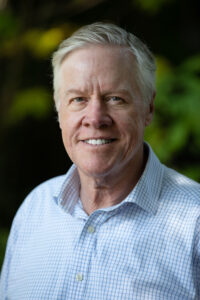Leading the Way, Together
July 24th, 2024
July 24th, 2024

Board Chair William Eacho. (Photo by Julia Walker Thomas/Friends of Acadia)
As chair of the Friends of Acadia Board of Directors for a year now, I continue to be struck and gratified by how frequently Acadia National Park and Friends of Acadia are cited as national leaders in tackling the many challenges facing our national parks.
These challenges include managing the park through climate change impacts, navigating a severe lack of affordable housing for our workforce, handling increased visitation, ensuring that our parks are accessible to all, and exploring co-stewardship of these special places in partnership
with Tribal nations.
At the National Parks Friends Alliance meeting this spring, National Park Service Director Chuck Sams listed the lack of workforce housing for park staff, volunteers, and concessionaires as the top challenge the National Park Service (NPS) is facing.
In doing so, he cited the work of Friends of Acadia to bring new housing to Acadia National Park as an example of leadership on the issue. In July, Friends of Acadia President Eric Stiles was invited to testify before the U.S. Senate National Parks Subcommittee on the need for affordable workforce housing, and to cite proposed solutions based on Friends of Acadia’s work.
Acadia and its partners continue to lead the way when it comes to managing protected lands in the face of a changing climate. This spring, Acadia hosted a group of Society for Conservation Biology Smith Fellows under the leadership of Schoodic Institute’s Climate Change Adaptation Scientist Chris Nadeau.
A 21st Century International Capacity Building Initiative brought individuals from parks and protected areas around the world. The group discussed storm damage at Sand Beach, how the Resist-Accept-Direct (RAD) framework is used in park management at Thunder Hole, visitor use challenges at Jordan Pond, and climate-smart, partnership-based restoration and co-stewardship at Great Meadow.
And Sierra—the national magazine produced by the Sierra Club—featured a story on the impacts of the winter storms in Acadia and how the park and its partners are implementing the RAD framework to manage through climate change.
In June, Acadia hosted a dozen members of the Biodiversity Funders Group—a professional association of environmental, conservation, and climate and energy grantmakers. They spent a day touring the park to learn about our climate-smart restoration work in Great Meadow and on the park’s summits. They learned how we’re using the RAD framework to make decisions about how to manage and repair damage in the park suffered during severe winter storms. And they learned more about the park’s co-stewardship efforts with the Wabanaki Tribes.
Leadership in conservation, or any endeavor, starts with innovation and collaboration, being willing to listen and to learn, to try new things and to adjust as needed. Most importantly, it’s about building strong partnerships, because we are stronger together than alone. Friends of Acadia is fortunate to have exceptional partnerships with Acadia National Park and the Schoodic Institute and to have earned the trust and support of our nearly 5,000 members and donors, thousands of volunteers, and the park’s surrounding communities.
That’s what we mean when we refer to the Power of Friends.
I hope you are as gratified as I am in these accomplishments and that you take great pride in supporting Acadia and in leading the way forward as our national parks and public lands face some daunting challenges.
Speaking of accomplishments, if you haven’t done so already, please visit the Friends of Acadia website to review our 2023 Impact Report at friendsofacadia.org/impactreport.
Together, we’re making great things happen, and there’s so much more to come.